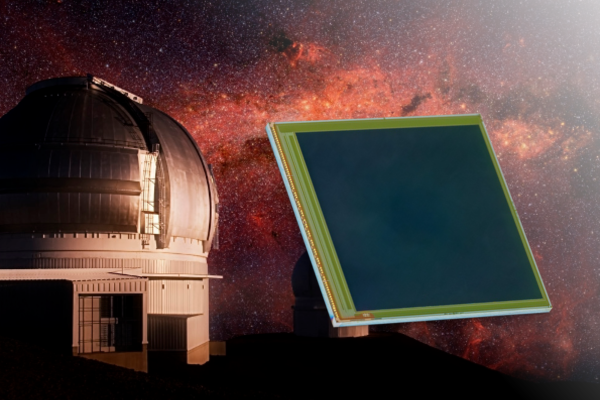Ike Pono
1KX1K Detector
‘Ike Pono’ was named by the late Donald Hall of the University of Hawaii – who inspired its design - after the Hawaiian for ‘far-seeing’. The array has 1024x1024 active pixels and a 15x15 micron pixel arranged on a 15 micron pitch. Ike Pono is the product of many years of research and development alongside the University of Hawaii, Institute of Astronomy on avalanche photodiode sensors for astronomical imaging.
The array is designed specifically for HgCdTe avalanche photodiodes that are fundamental to achieve the sensitivity needed by future astronomical instruments. Very weak signal levels down to a few photons per kilosecond and long exposure times up to many days present very special demands on the focal plane array. Ike Pono has nondestructive readout so multiple frames can be acquired during the exposure to employ noise reduction techniques, such as ‘down-the-ramp’. The array has comprehensive reference pixels that enable any fluctuations in power supply voltages or temperature during long exposures to be compensated.
Self-luminescence (glow) from the silicon components has been minimized by a combination of integrated circuit component design, operating with very low voltages and dedicating the top two layers of metal as blocking layers. There are 16 parallel outputs to enable slow clocking and heavy noise filtering.
The HgCdTe avalanche photodiode array (APD) is crucial to the performance of the device. Leonardo photodiodes use metal-organic vapor-phase epitaxy, MOVPE, as the growth process and this provides complete flexibility of band gap and doping levels. APDs use a separate absorber and multiplication layer so all the photons receive the same avalanche gain. The absorber is continuous providing 100% fill factor and near 100% internal QE. The mesa device technology results in complete separation of the pixels minimizing inter-pixel capacitance and cross-talk.

- Key Features and Benefits
- Technical Specifications
- Designed for ultra-low flux imaging
- Flexible integration and readout modes
- Multiple independently resettable windows
- Enhanced sensitivity due to avalanche photodiodes
- Multiple reference features
- Windowing function to 1x16 pixels
- Very high sensitivity
Packaging Option
- Currently offered as a bare array or in a customer package
- Please contact us to discuss packaging options
Technical Specifications (Physical Parameters)
- Array: 1024 x 2024 pixels
- Pixel Pitch: 15 μm
Technical Specifications (ROIC Operation)
- Reset modes: Global or rolling
- CDS modes: Rolling or Read-Reset-Read per row
- Control and operation: Single serial interface and clock
- Power consumption: 30 mW
- Number of outputs: 16
- Maximum frame rate: 32 frames per second
- Windowing: Multiple window options
- Avalanche gain control: Single –ve power supply up to 18 V
Technical Specifications (Infrared Imaging)
- Infrared sensor: HgCdTe avalanche photodiodes
- Waveband for full gain: 0.8 to 2.5 um (partial to 3.5 um)
- Typical read noise: 1 electron at a typical gain of x25
- Noise figure: < 1.2
- Maximum gain: 100x
- Operating temperature: 40 to 140 K
- Dark current: 0.001 e/s/pixel at 70 K

